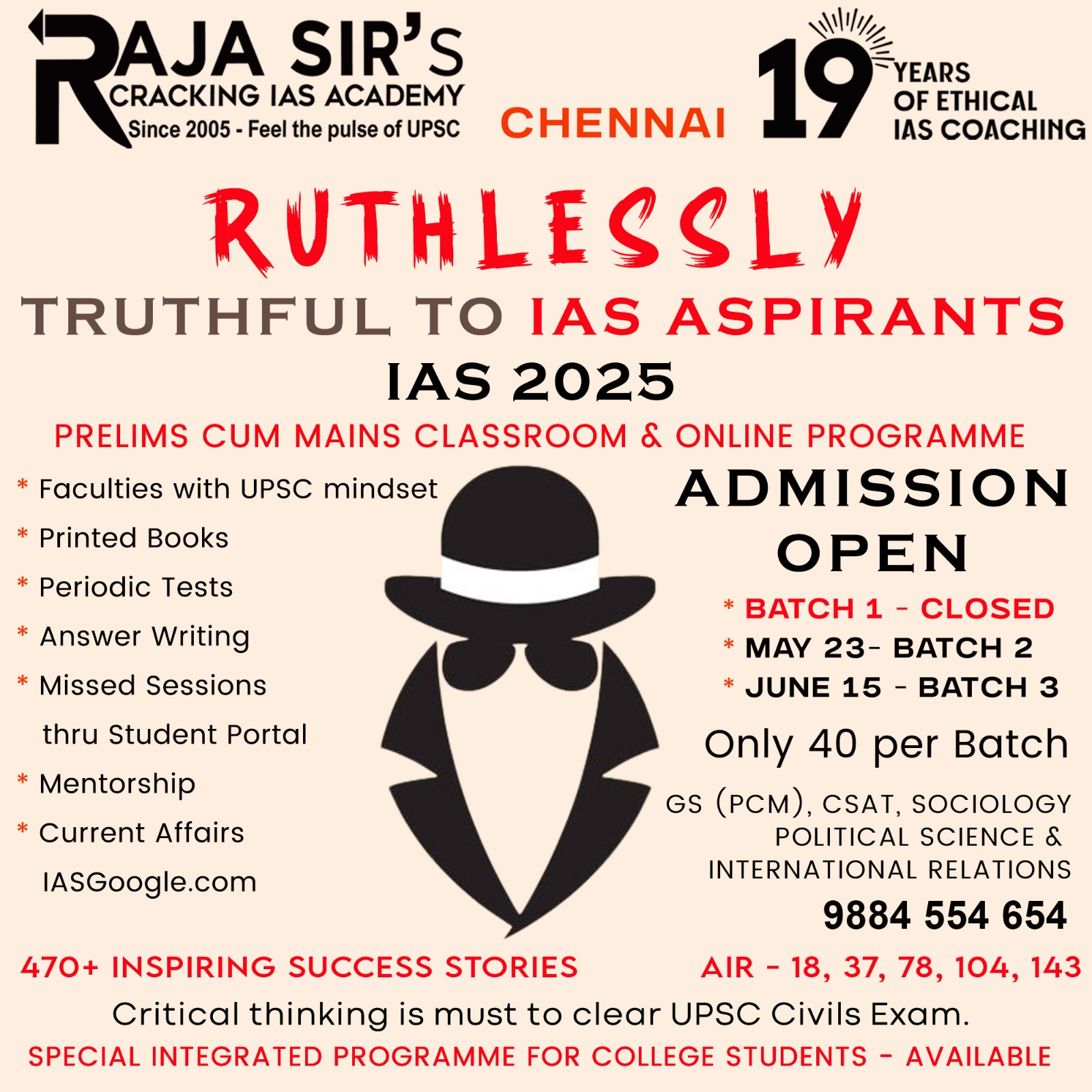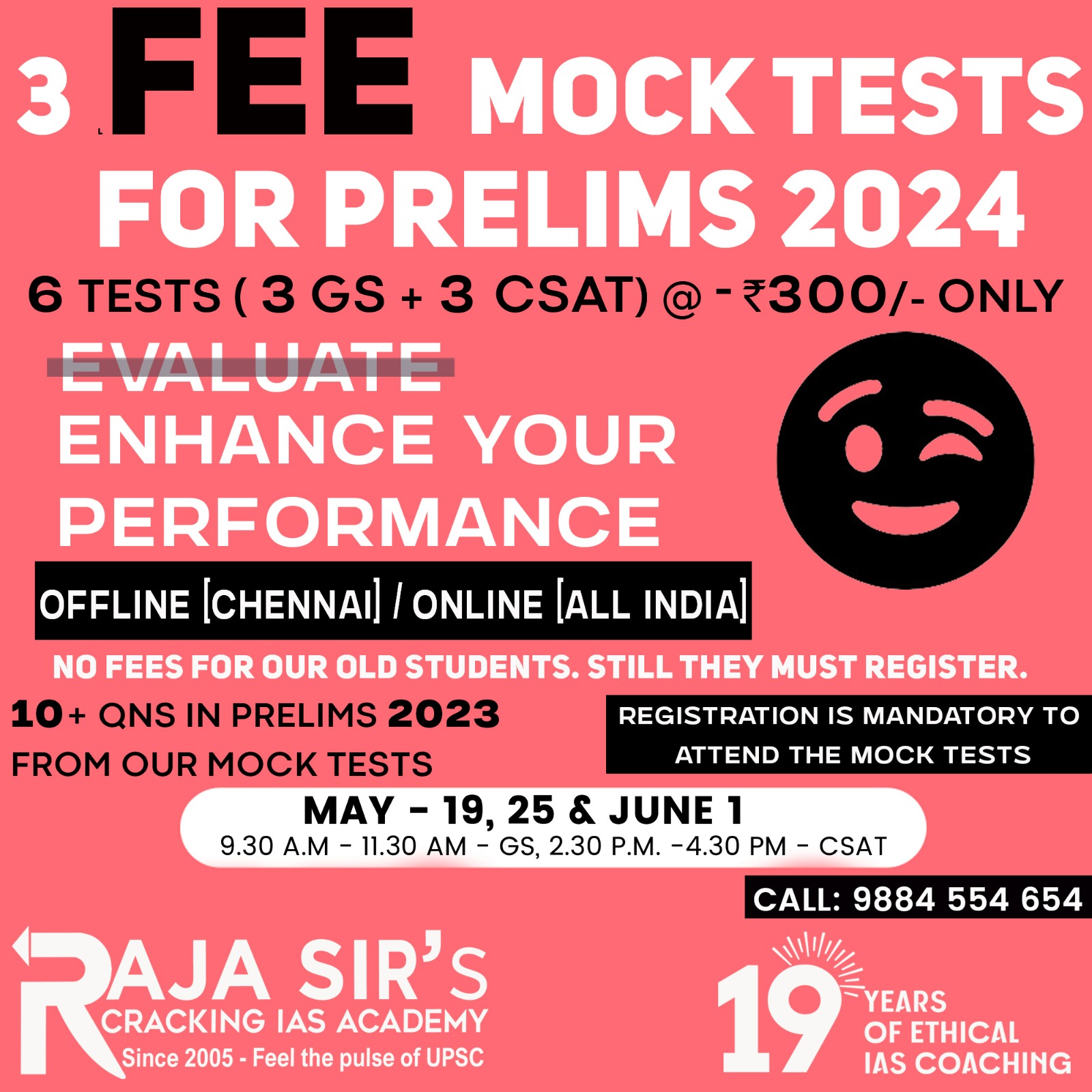- Home
- Prelims
- Mains
- Current Affairs
- Study Materials
- Test Series
Hit List Questions 20 - PPP 100 PRELIMS 2024 - 38
QUESTIONS & EXPLANATIONS:
|
1. |
Consider the following minerals: 1. Indium 2. Niobium 3. Pitchblende 4. Lithium 5. Titanium How many of the above given minerals have been removed from the Atomic Minerals list through the Mines and Minerals (Development & Regulation) Amendment Act, 2023?. (a) Only two (b) Only three (c) All five (d) Only four Note: 2,4,5 omitted. |
|
||||||||||||||||||||||||||||||||||||||||||||||||||||||||||||||||||||||||||
|
2. |
Kampala Declaration that was recently in news, is related to (a) Labour missues (b) Environmental issues (c) Nuclear Weapons (d) Cluster ammunitions Note: |
B |
||||||||||||||||||||||||||||||||||||||||||||||||||||||||||||||||||||||||||
|
3. |
Which of the following statements is/are correct? 1. In a tightening cycle, monetary policy is most effective when the liquidity is in deficit mode. 2. Under the MPC framework, if average inflation breaches the upper or lower tolerance band for any three consecutive quarters, it would mean a failure to achieve the inflation target. Select the correct answer using the code given below: (a) 1 only (b) 2 only (c) Both 1 and 2 (d) Neither 1 nor 2 Note: |
C |
||||||||||||||||||||||||||||||||||||||||||||||||||||||||||||||||||||||||||
|
4. |
Consider the following statements regarding Urea Gold: 1. It is created by infusing urea with Zinc a micro mineral for plant growth. 2. It is inferior to Neem-coated urea in terms of economic viability. 3. Humic acid is removed from it to increase its targeted delivery. How many of the above statements are correct? (a) Only one (b) Only two (c) All three (d) None Note: https://www.cnbctv18.com/economy/pm-narendra-modi-rajasthan-launch-what-is-urea-gold-17350961.htm Urea Gold
Urea Gold Is Better Than Others
Neem-coated urea
|
D |
||||||||||||||||||||||||||||||||||||||||||||||||||||||||||||||||||||||||||
|
5. |
The ClearSpace-1 mission, to be launched in 2026, is a Space Debris Removal mission of the (a) Japan (b) Russia (c) China (d) European Space Agency
Note: https://www.thehindu.com/children/what-is-space-junk-why-is-it-a-serious-problem/article34532546.ece |
D |
||||||||||||||||||||||||||||||||||||||||||||||||||||||||||||||||||||||||||
|
6. |
With reference to the Bakhshali manuscript, consider the following statements: 1. It contains the oldest recorded origins of the symbol “zero”. 2. It predates the work of Brahmagupta. How many statements given above are correct? (a) 1 only (b) 2 only (c) Both 1 and 2 (d) Neither 1 nor 2 Note:
Influence on Modern Mathematics
|
C |
||||||||||||||||||||||||||||||||||||||||||||||||||||||||||||||||||||||||||
|
7. |
Consider the following statements with reference to Luna 25: 1. It is China’s lunar mission. 2. It is lighter and lacks a rover. 3. It landed on Moon in its very first attempt. How many of the above statements are correct? (a) Only one (b) Only two (c) All three (d) None Note: Only 2 is correct. https://indianexpress.com/article/technology/science/watch-this-space-chandrayaan-luna-8900507/ |
A |
||||||||||||||||||||||||||||||||||||||||||||||||||||||||||||||||||||||||||
|
8. |
The Ritu Chhabaria judgment seen in news refer mainly to the context of (a) Granting Bail (b) Marital rape (c) Appointing Judges of Supreme Court (d) Punishing IPS officers Note: The Ritu Chhabaria judgment, the court held that “the right of default bail under Section 167(2) of the Criminal Procedure Code (CrPC) is not merely a statutory right, but a fundamental right that flows from Article 21 of the Constitution” to protect accused persons from the “unfettered and arbitrary power of the State”. In Ritu Chhabaria, the court held that an incomplete chargesheet filed by the investigating agency without completing the investigation will not defeat the right of the accused for default bail. As investigating authorities routinely filed incomplete or supplementary charge sheets within the 60/90-day period, to prevent the accused from seeking default bail. |
A |
||||||||||||||||||||||||||||||||||||||||||||||||||||||||||||||||||||||||||
|
9. |
1. In a "normal" water year, Karnataka is bound to release 419 TMC (thousand million cubic feet) of water from June to May to Tamil Nadu. 2. Karnataka, the upper riparian state of the Cauvery basin, has agreed to transfer water to Tamil Nadu every month. Which of the statements given above is/are correct w.r.t. Cauvery Water Sharing? (a) 1 only (b) 2 only (c) Both 1 and 2 (d) Neither 1 nor 2 Note: Cauvery river
Cauvery Water Dispute
|
B |
||||||||||||||||||||||||||||||||||||||||||||||||||||||||||||||||||||||||||
|
10. |
Consider the following statements regarding Urea subsidy: (i) The subsidy amount is transferred directly into farmers’ account (ii) It also includes freight subsidy for movement of urea across the country. (iii) It is wholly financed by Central Government of India through budgetary support. Select the correct answer using the code given below: (a) (i) & (ii) only (b) (ii) & (iii) only (c) (iii) only (d) (i), (ii) & (iii) Note: The subsidy amount is transferred into fertilizer’s company account upon verification of sale to farmers through Aadhaar. The price of Urea is regulated by Central Government and it is Rs. 5.36/kg and the per kg subsidy by the government varies with the market fluctuations in the price of gas (input). Urea Subsidy Scheme
Nutrient Based Subsidy (NBS) Scheme · The NBS scheme is being implemented since 2010 by the Department of Fertilisers, Ministry of Chemicals and Fertilisers. · Under the scheme, fertilisers are provided at subsidised rates based on the nutrients contained, namely Nitrogen (N), Phosphate (P), Potash (K) and Sulphur (S). It does not include urea-based fertilisers. · Moreover, fertilisers fortified with secondary nutrients and micronutrients (sulphur, zinc, boron, iron, manganese, and copper) are given additional subsidies. · A fixed rate of subsidy (in ₹per Kg basis) is announced on nutrients (N, P, K & S) by the government annually. · Objectives of the NBS scheme: o To ensure the nation’s food security o To improve agricultural productivity o To ensure the balanced application of fertilisers How Is The NBS Fertilizer Subsidy Paid & Who Gets It? · Farmers buy non-urea fertilisers at MRPs below their standard supply-and-demand-based market rates or what it costs to produce/import them. The Centre foots the difference as a subsidy. · The subsidy under NBS goes to fertiliser companies, although its ultimate beneficiary is the farmer who pays MRPs less than the market-determined rates. · Since 2018, the subsidy is being paid through a Direct Benefit Transfer (DBT) system after the actual sale of fertilisers to farmers by retailers (there are over 2.3 lakh retailers across India). · Each retailer has a point-of-sale (PoS) machine linked to the Department of Fertilisers’ e-Urvarak DBT portal. Farmers are required to furnish his/her Aadhaar or Kisan Credit Card number. · The quantities of the individual fertilisers purchased, along with the buyer’s name & biometric authentication, must be captured on the PoS device. · A company’s subsidy claim is processed weekly for sales registered on the e-Urvarak platform (the Integrated Fertiliser Management System (iFMS) that monitors fertiliser movement). Fertilizer Imbalance Issue with NBS Scheme · Urea is not included in the NBS scheme and remains under price control (MRP is officially fixed). On the other hand, the MRPs of non-urea fertilisers under the NBS scheme are decontrolled (fixed by the companies). Thus, they retail way above urea while attracting lower subsidies. This has led the farmers to use more urea, worsening the fertiliser imbalance. Issues With Fertilizers Subsidy Schemes (NBS and Urea Subsidy) Environmental and Economic Cost · Fertilizer subsidy is the second-biggest subsidy after food subsidy. Schemes like NBS promote the injudicious use of fertilisers, which are the major emitters of nitrous oxide (N2O — a potent greenhouse gas and ozone-depleting substance), damaging the soil health and the fiscal health of the economy. · The current ratio of NPK (desirable ratio of is 4:2:1) in agricultural soil in several states is skewed towards nitrogen. This imbalance causes widespread deficiency of secondary nutrients and micronutrients and soil alkalinity and salinity. Measures Required · The government must bring reforms to promote the balanced use of fertilisers and make efforts to do away with fertiliser subsidies in the coming years. · To begin with, it must introduce a decontrol measure (don’t fix the MRP, leave it to the market) in the urea sector. Gradually, fertiliser subsidies must be replaced with Direct Benefit Transfers to farmers. · Simultaneously, efforts must be made to promote organic manure, bio-fertilisers, and city compost as they come with a much lower environmental footprint than synthetic fertilisers. They increase organic soil carbon and support microbial life. They also promote more efficient use of synthetic fertilisers. One Nation, One Fertiliser Scheme · Union Ministry of Chemicals and Fertilisers announced the implementation of the “Pradhan Mantri Bhartiya Jan Urvarak Pariyojana (PMBJP) – One Nation One Fertiliser” scheme. · Under the scheme, all fertiliser manufacturers under the fertiliser subsidy scheme will be required to use a single brand and logo for fertilisers. · The single brand name under this scheme will be “Bharat”, and the logo will be the PMBJP logo. The single brand name for UREA, DAP, MOP and NPKS etc., would be BHARAT UREA, BHARAT DAP, BHARAT MOP, etc. · The new “Bharat” brand name and PMBJP logo will cover two-thirds of the front of the fertiliser packet. The manufacturing brands can display their information only on the remaining one-third space! Rationale behind the Scheme · Standardisation: It eliminates the dilemma of farmers in choosing one of the many brands available in the market. · Recognition: Despite taking huge subsidies in production, fertiliser manufacturers sale the fertilisers under their brand identity and not under the government name. · Affordability: Due to using only a single brand name, there will be no added attraction for any particular brand. So, fertilisers can be made available to farmers very quickly at affordable prices. · Reduction in Freight Charges: The presence of different brand-wise demands for fertilisers in specific areas results in high transport costs and freight subsidies. But when there is only one brand, the different brand-wise demand will not be there because there will be less freight movement. Criticisms against the Scheme · Adverse Impact on Fertilisers Quality: Since there is less scope for building a unique brand identity, it will discourage manufacturers from bringing newer and more efficient products into the market. · Hindrance for Attaining Self-sufficiency in Fertilisers: The government wants to become self-sufficient in fertilisers, which are currently imported in large quantities. But without any impetus for manufacturers to improve their production, this target cannot be achieved. |
B |
||||||||||||||||||||||||||||||||||||||||||||||||||||||||||||||||||||||||||
|
11. |
Which of the following are the uses of Artificial Intelligence? 1. It can be used to conserve water. 2. It can be used to fight wildfires. 3. It can be used to identify and recover recyclables. 4. AI models involve zero carbon emissions. (a) 1 and 2 only (b) 1, 2 and 3 only (c) 1, 2 and 4 only (d) 1, 2, 3, 4 Note: https://www.cbsnews.com/news/artificial-intelligence-carbon-footprint-climate-change/ |
B |
||||||||||||||||||||||||||||||||||||||||||||||||||||||||||||||||||||||||||
|
12. |
Advantages of the Small Modular Reactors include 1. Smaller core damage frequency and radioactive contamination. 2. Enhanced seismic isolation and passive safety features. 3. Lower spent nuclear fuel storage. 4. Compatibility with brownfield sites. (a) 1 and 2 only (b) 1, 2 and 3 only (c) 1, 2 and 4 only (d) 1, 2, 3, 4 Note: |
D |
||||||||||||||||||||||||||||||||||||||||||||||||||||||||||||||||||||||||||
|
13. |
International Debt Statistics’ is released by (a) World Bank (b) IMF (c) World Economic Forum (d) WTO
Note: |
A |
||||||||||||||||||||||||||||||||||||||||||||||||||||||||||||||||||||||||||
|
14. |
Which of the following statements are true regarding “Central Issue Price” (CIP)?. (i) It is the price at which food grains are issued to the state governments. (ii) It is fixed by Food Corporation of India. (a) (i) only (b) (ii) only (c) Both (i) and (ii) (d) Neither (i) nor (ii)
Note: Central Issue Price (CIP) is the price at which food grains (wheat and rice) are issued to the state governments/ UTs from the central pool at uniform prices for distribution under TPDS. CIP is fixed by Department of Food and Public Distribution, Ministry of Consumer Affairs, Food and Public Distribution. |
A |
||||||||||||||||||||||||||||||||||||||||||||||||||||||||||||||||||||||||||
|
15. |
Consider the following statements regarding the Parliamentary Privileges Committee: 1. The Parliamentary Privilege Committee is a 10-member panel in the Rajya Sabha and a 15-member panel in the Lok Sabha. 2. The Chairman of the Parliamentary Privilege Committee is not empowered to refer, suo motu any question of privilege to the Committee for examination, investigation and report. 3. In the Rajya Sabha, the deputy chairperson heads the committee of privileges. How many of the above statements are correct? (a) Only one (b) Only two (c) All three (d) None Note: |
C |
||||||||||||||||||||||||||||||||||||||||||||||||||||||||||||||||||||||||||
|
16. |
The “Plastic Overshoot Day Report, 2023” report has been published by (a) Earth Action (b) Green Peace (c) UNEP (d) UN Ocean Note: |
A |
||||||||||||||||||||||||||||||||||||||||||||||||||||||||||||||||||||||||||
|
17. |
With reference to the Anna Bhau Sathe, consider the following statements: 1. He was inspired by the Russian revolution and the Communist ideology. 2. He dedicated his most famous novel Fakira to Subhas Chandra Bose. Which of these statements is/are correct? (a) 1 only (b) 2 only (c) Both 1 and 2 (d) Neither 1 nor 2 Note: He dedicated his most famous novel Fakira to Dr. B.R. Ambedkar. |
A |
||||||||||||||||||||||||||||||||||||||||||||||||||||||||||||||||||||||||||
|
18. |
Consider the following statements w.r.t. Gut Flora. 1. It contributes to nutrient absorption. 2. It prevents harmful substances from entering the bloodstream. Which of the above statements is/are incorrect? (a) 1 only (b) 2 only (c) Both 1 and 2 (d) Neither 1 nor 2 Note: |
D |
||||||||||||||||||||||||||||||||||||||||||||||||||||||||||||||||||||||||||
|
19. |
The Northern Sea Route connects (a) Eastern and Western Arctic Ocean (b) Mediterranean Sea and Black Sea (c) Dead sea and Red Sea (d) North Sea and Baltic Sea Note: |
A |
||||||||||||||||||||||||||||||||||||||||||||||||||||||||||||||||||||||||||
|
20. |
WPI and CPI are two different baskets of goods and services. Consider the following statements. 1. Repo rate changes transmit through the money market to the entire the financial system, which, in turn, influences aggregate demand – a key determinant of inflation and growth. 2. The repo rate is higher than the reverse repo rate. Which of the statements given above is/are correct? (a) 1 only (b) 2 only (c) Both 1 and 2 (d) Neither 1 nor 2 Note: https://indianexpress.com/article/explained/everyday-explainers/halal-certificate-up-ban-9032320/ |
C |
||||||||||||||||||||||||||||||||||||||||||||||||||||||||||||||||||||||||||
|
21. |
Consider the following statements. 1. Clause 1 of Article 343 of Indian Constitution says “The official language of the Union shall be Hindi in Devanagari script”, and “The form of numerals to be used for the official purposes of the Union shall be the international form of Indian numerals.” 2. Article 351 of Indian Constitution says “It shall be the duty of the Union to promote the spread of the Hindi language, to develop it so that it may serve as a medium of expression for all the elements of the composite culture of India”. Which of the above statements is/are incorrect? (a) 1 only (b) 2 only (c) Both 1 and 2 (d) Neither 1 nor 2 Note: |
D |
||||||||||||||||||||||||||||||||||||||||||||||||||||||||||||||||||||||||||
|
22. |
Which of the above statements is/are incorrect w.r.t. “Biodiversity Heritage Sites” ?. 1. Under the Biological Diversity Act, 2002, the State Government in consultation with local bodies may notify areas as Biodiversity Heritage Sites. 2. Declaration of an area as Biodiversity Heritage Site does not put any restriction on the prevailing practices and usages of the local communities. Which of the statements given above is/are correct? (a) 1 only (b) 2 only (c) Both 1 and 2 (d) Neither 1 nor 2 Note: https://pib.gov.in/PressReleaseIframePage.aspx?PRID=1944380
Biodiversity Heritage Sites in India
Nallur Tamarind Grove, Karnataka
Hogrekan, Karnataka
Ambaraguda, Karnataka
Glory of Allapalli
Ameenpur Lake
Majuli Island in Assam
Arittapatti Biodiversity Heritage Site
Mahendragiri Hill Biodiversity Heritage Site
Yaya Tso Lake
|
C |
||||||||||||||||||||||||||||||||||||||||||||||||||||||||||||||||||||||||||
|
23. |
1. It is the rate at which short term and long-term funds are borrowed and lent in the money market. 2. A tight liquidity condition leads to a fall in call money rate. 3. It has maturity period of 1 day only. Which of the above statements is/are correct w.r.t. Call Money Rate? (a) 1 only (b) 2 only (c) 1 and 3 only (d) 3 only
Note: Call money rate is the rate at which short term funds are borrowed and lent in the money market. The duration of the call money loan is 1 day. Banks resort to these types of loans to fill the asset liability mismatch, comply with the statutory CRR and SLR requirements and to meet the sudden demand of funds. RBI, banks, primary dealers etc are the participants of the call money market. Demand and supply of liquidity affect the call money rate. A tight liquidity condition leads to a rise in call money rate and vice versa. |
D |
||||||||||||||||||||||||||||||||||||||||||||||||||||||||||||||||||||||||||
|
24. |
European Union’s One health approach is concerned with (a) Antimicrobial resistance (b) Hidden Hunger (c) Communicable Diseases (d) Gut flora Note: |
A |
||||||||||||||||||||||||||||||||||||||||||||||||||||||||||||||||||||||||||
|
25. |
Which of the following best describe “Fiscal Drag”? (1) Decrease in the GDP growth rate due to higher Fiscal Deficit. (2) Increase in tax collection due to higher rate of inflation. (3) Decrease in aggregate demand, when the people move from low tax bracket to high tax bracket. (a) 1 and 3 only (b) 1 and 2 only (c) 2 and 3 only (d) 1, 2 and 3 Note: Fiscal drag happens when the government’s net fiscal position fails to cover the net savings desires of the private economy, also called the private economy’s spending gap.
Fiscal drag is normally associated with progressive tax rates. Because of progressive taxes, the government will get more taxes when the economy is booming. This also helps slow the rate of increase in demand, reducing the pace of growth, making it less likely to result in higher inflation. Thus fiscal drag is an automatic stabilizer, as it acts naturally to keep demand stable. Also note that fiscal drag means greater tax burden for people. And the greater tax burden can lead to less consumer spending. About the Fiscal Cliff: The fiscal cliff refers to a combination of expiring tax cuts and across-the-board government spending cuts that was scheduled to become effective December 31, 2012. The story of Fiscal Cliff starts with the subprime crisis. Hence we covered that first.
So period from Jan 1, 2013, was supposed to be a period of high taxes. A sudden condition of high taxes and reduced public expenditure after a long period of tax cuts and liberal public expenditure is known as Fiscal Cliff. In the case of US, it was more a technical or policy issue, but to avoid this policy issue, the two houses of the US congress had to reach a consensus, which they didn’t reach initially. Fiscal boost and fiscal drag are the counter-cyclical effects of progressive direct taxes and welfare benefits on the movement of GDP over a period of time. In fiscal boost, a downturn in GDP during a recession would be accompanied by a fall in real incomes. Fiscal drag happens when incomes rise due to wages following prices higher pushes or drags millions of taxpayers into the higher marginal tax rate brackets. Fiscal drag has the effect of raising government tax revenue without raising tax rates. |
C |









 Latest News
Latest News




 General Studies
General Studies